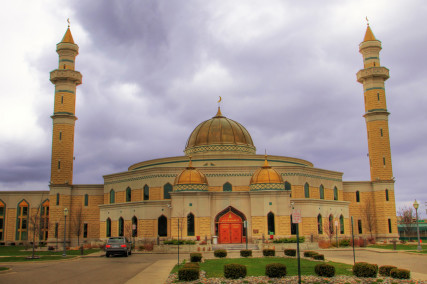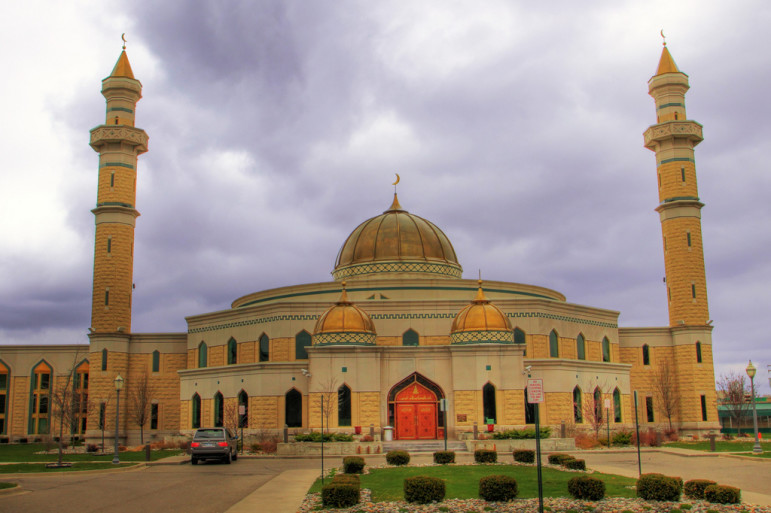As the results in the Michigan primary came in, some pundits highlighted the election results in Dearborn, Michigan: the most Muslim city in America gave 60 percent of its vote to Jewish candidate Bernie Sanders and Donald Trump. This obviously means Muslims back a Jewish candidate or an anti-Muslim candidate, right? No. This result tells us NOTHING.

Islamic Center Of America, Dearborn, Michigan. Photo by “Ryan” via Flickr Creative Commons https://www.flickr.com/photos/ryanready/5694563549/
There are a bunch of small problems with this analysis (that I’ll cover below), but there is one HUGE problem: You can’t take overall percentages and infer how they were created.
It’s a classic problem that social scientists refer to as the “ecological fallacy.” This is a fallacy occurs when we use aggregate results (like election outcomes) to mistakingly guess about individual decisions (like how groups voted).
To give a humorous example, I once saw a poster that said:
Half of Americans vote
Half of Americans read the newspaper
Let’s hope it’s the same half
The joke lies in the fact that it could be that no American voters read the paper or that all of them do. We just don’t know.
The same goes for Dearborn, Michigan. The city is known as being home to many Muslims. We don’t know how many; the Census tells us that around 30 percent of the city is Arab-American.
So, let’s use that figure. Let’s say the voters in the Democratic primary were just like everyone else in Dearborn: 30 percent Arab-American. And rounding a bit, 60 percent of the voters chose Sanders and the rest voted for Clinton.
Question: What is the percentage of voters who were both Arab-American AND Sanders supporters?
| Clinton | Sanders | ||
| Arab-American | ?? | ?? | 30% |
| Not Arab-American | ?? | ?? | 70% |
| 40% | 60% | 100% |
Answer: We have no clue.
It could be that all of the Arab-Americans voted for Sanders. This would mean that those who aren’t Arab-American split their vote, with a 57% voting for Clinton (that’s 40% Clinton, 30% Sanders).
| Clinton | Sanders | ||
| Arab-American | 0% | 30% | 30% |
| Not Arab-American | 40% | 30% | 70% |
| 40% | 60% | 100% |
Or, it could be that NO Arab-Americans voted for Sanders and everyone else broke 6-to-1 for Sanders.
| Clinton | Sanders | ||
| Arab-American | 30% | 0% | 30% |
| Not Arab-American | 10% | 60% | 70% |
| 40% | 60% | 100% |
Or, maybe being Arab-American had no impact on the vote at all. Both groups could go 60-40 for Sanders:
| Clinton | Sanders | ||
| Arab-American | 12% | 18% | 30% |
| Not Arab-American | 28% | 42% | 70% |
| 40% | 60% | 100% |
All three of these results are possible. Based on the outcome, Arab-Americans may have all voted for Sanders, gave zero votes to Sanders, or voted for some range in between.
That’s the best we can do: zero to one-hundred percent support by Arab-Americans.
If (and it’s a HUGE if) we had data at the precinct level on the number of voters who are Muslim and the number of votes for each candidate, there are statistical techniques that can be used to estimate the percentage of Muslims who voted for each candidate (see Gary King’s work on ecological inference). Here are four reasons why we can’t do this:
1) We don’t know what percentage of the voting age population is Arab-American. We know about how many of the entire population is Arab-American, but that includes every child, non-citizen, and ineligible voter.
2) We don’t know how many Muslims live in Dearborn. Not all Arab-Americans are Muslim. Not all Muslims are Arab-American.
3) Of the 60,000 registered voters in Dearborn, only 20,000 voted in the primary. How many of the 20,000 all Arab-American? All of them; none of them; most of them; or few of them? We don’t know.
4) At the polls, 8,000 voted in the Republican primary and 12,000 voted in the Democratic primary. Which way did Muslim voters go? What percentage did they comprise in each party?
With all of these problems, we can’t come close to being able to say what happened in Dearborn. The only way that the results matter is if one acts as if Dearborn “might as well be” 100 percent Muslim. It isn’t. And it’s results tell us nothing about how Muslims in Dearborn voted.
As a researcher, that is frustrating. As a voter, I like that my votes can’t be linked back to my race, gender, or religion.
What we need to answer the question about groups voting are larger, better surveys. What we don’t need are knee-jerk reactions from pundits that reveal nothing other than their ignorance.
Don’t miss any more posts from the Corner of Church & State. Click the red subscribe button in the right hand column. Follow @TobinGrant on Twitter and on the Corner of Church & State Facebook page.





